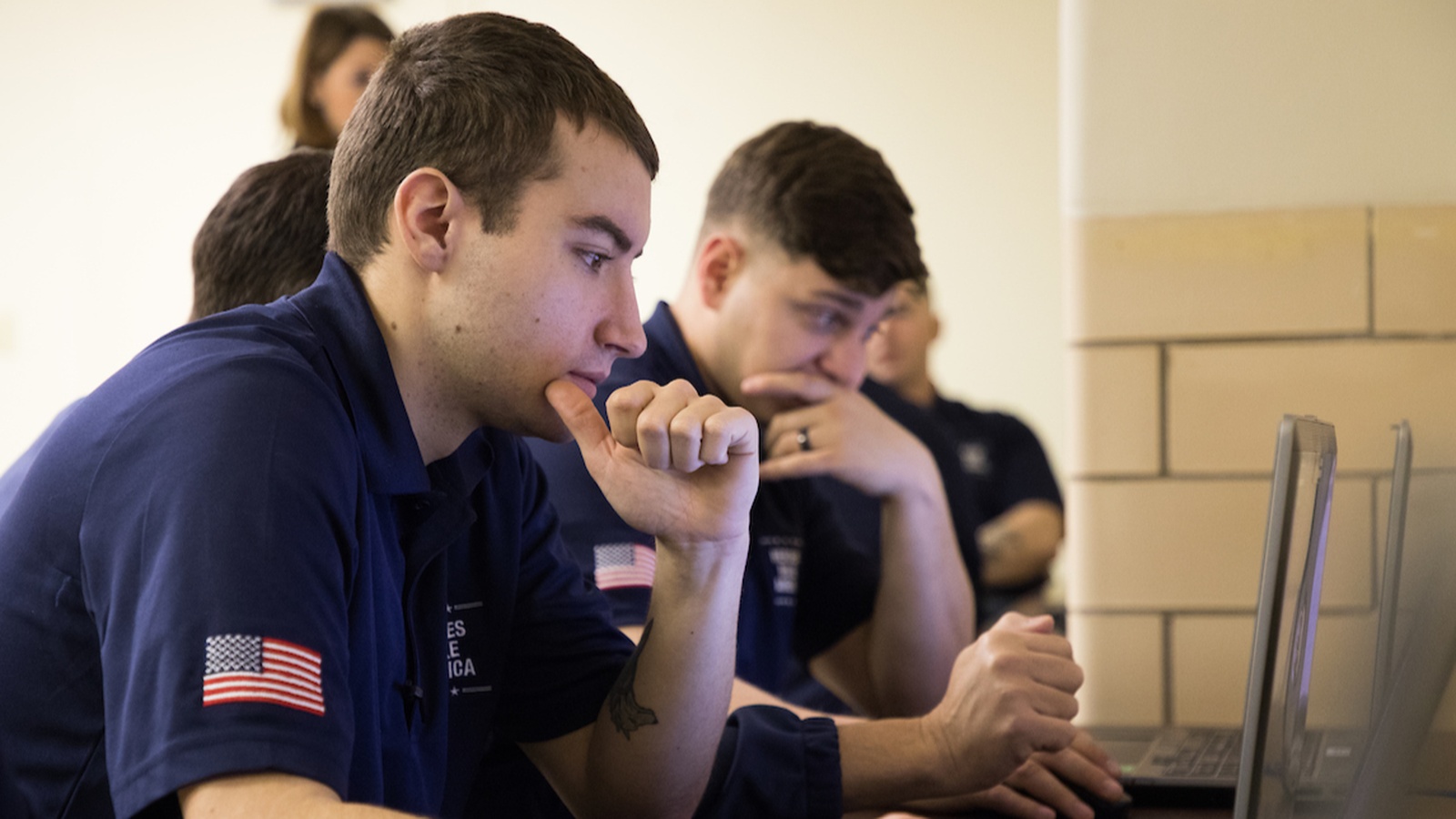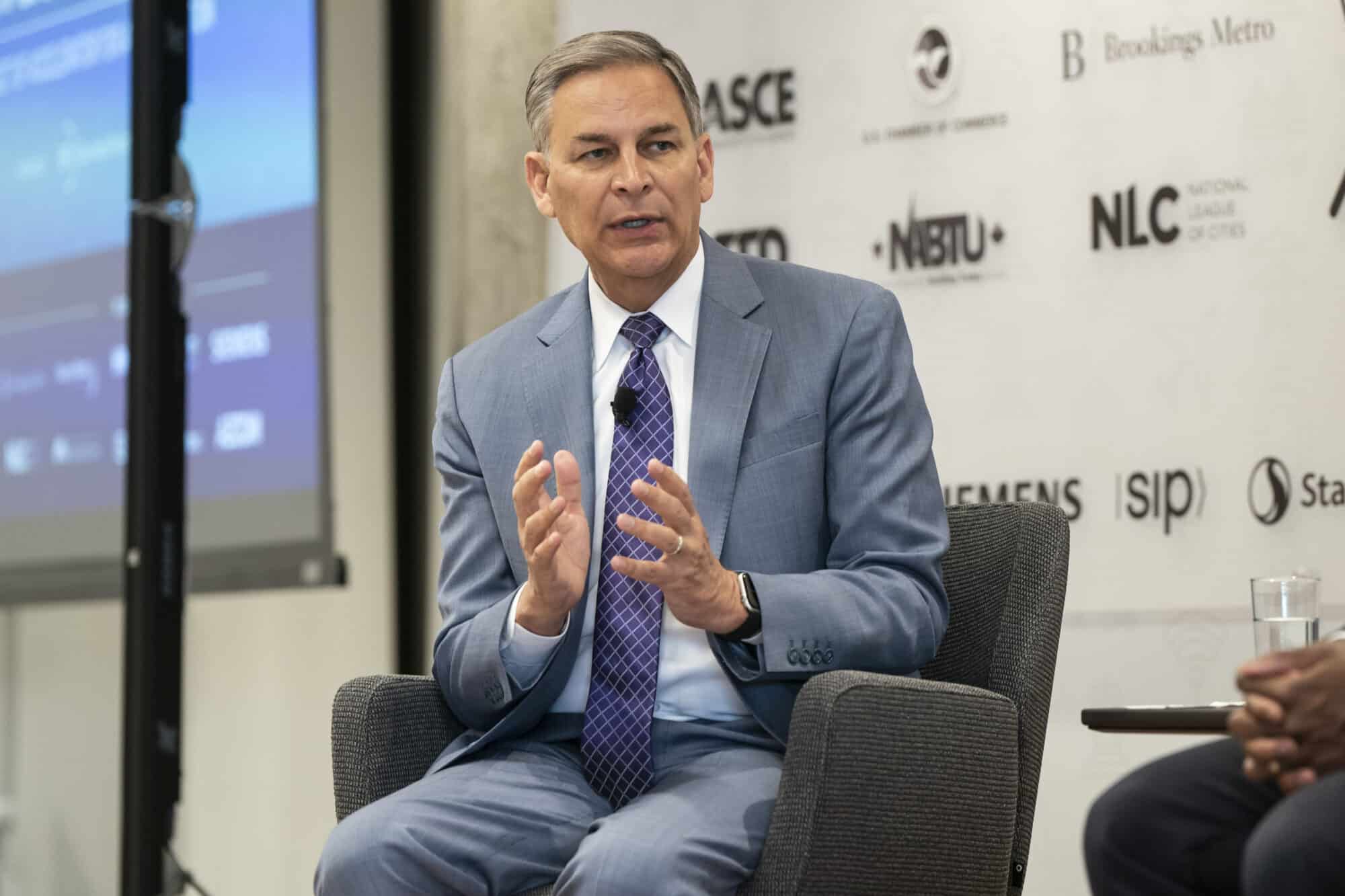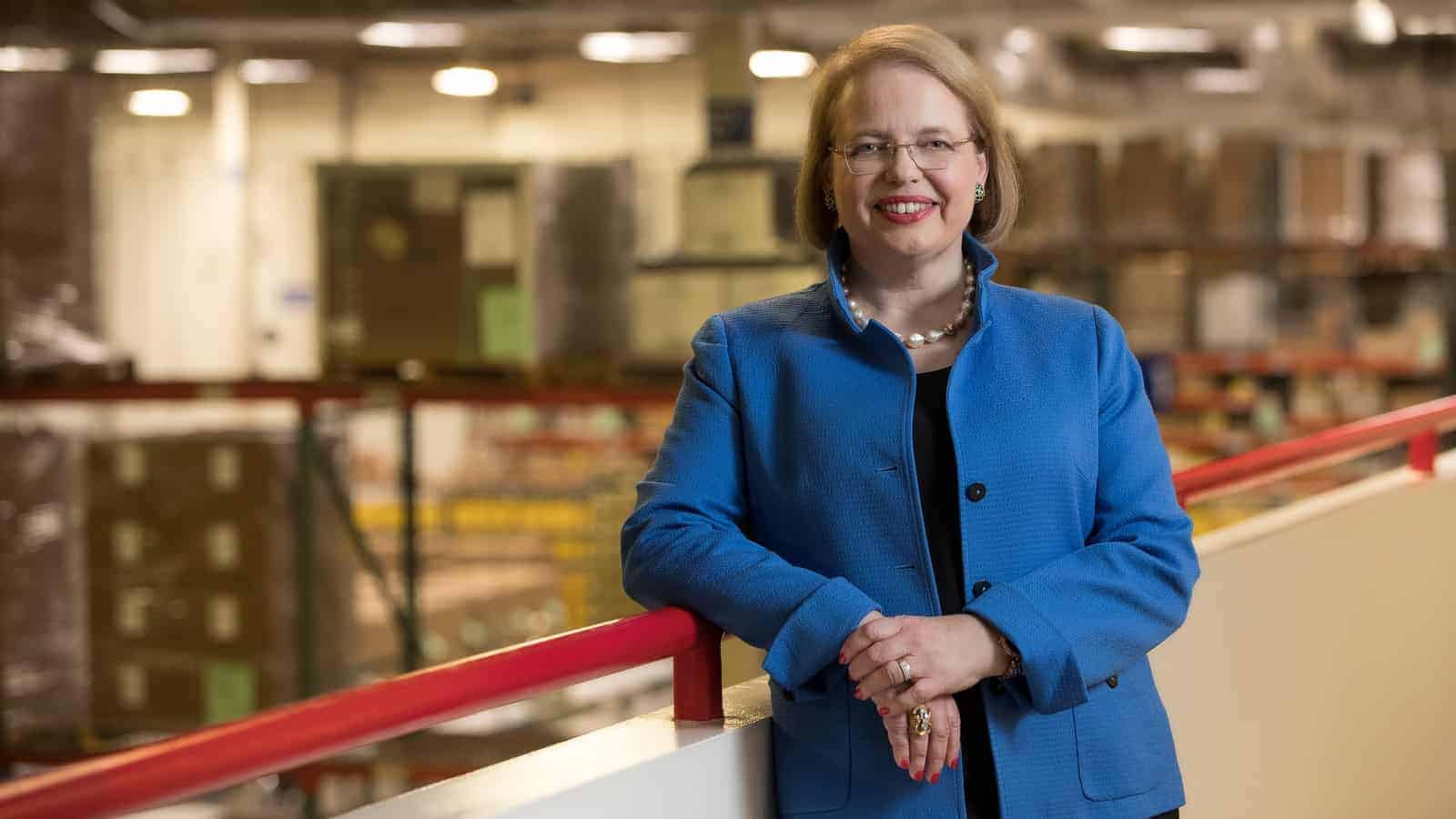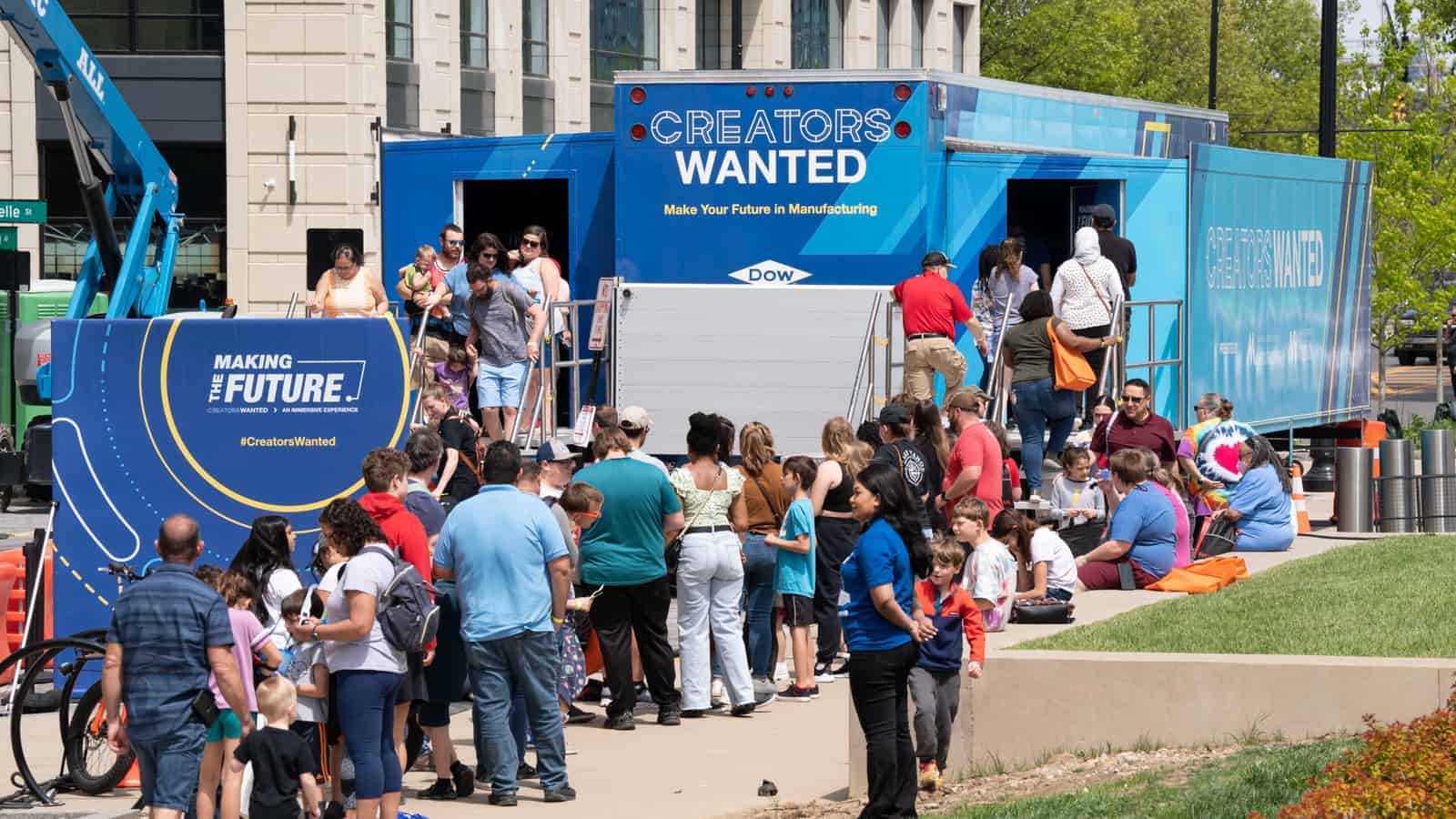Army, Navy, Air Force, and Marines! Heroes MAKE America is Reaching More Veterans

When service members leave the military, manufacturers are quick to say: “Come on over!” Military skills are usually a great match for manufacturing careers, which require attention to detail, technical abilities and creative thinking. And there’s no better matchmaker than the Manufacturing Institute’s Heroes MAKE America initiative, which since 2018 has been offering training certification programs and career courses to transitioning service members and veterans.
Today, HMA not only serves service members on military installations across the country but has also expanded its reach via a virtual training program.
Widening the reach: Now in its second year, the virtual training program has allowed HMA to impact service members on a national scale.
- For the first time, members from four branches—Army, Air Force, Marine Corps and Navy—are participating in the same class at the same time.
- Additionally, the geographic range of participants has increased to comprise students located far and wide, including in Alaska, Arizona, Delaware, Kansas and Kentucky.
- The program has reached more than 120,000 prospective students through local transition assistance, HMA’s LinkedIn and Facebook presence and the SkillBridge website.
How it works: HMA partnered with Texas State Technical College to create a virtual nine-week training and certification program.
- Participants earn nationally portable, industry-recognized Certified Production Technician certification as well as an OSHA 10 certification.
- Through Heroes Connect, HMA also partners with sponsors like Johnson & Johnson, The Caterpillar Foundation, Amazon, Howmet Aerospace, WestRock, Saint-Gobain, Atlas Copco, Cargill, FUCHS Lubricants Company, C.H. Guenther & Sons, Honda Foundation, Niagara Bottling and the NAFEM, PPI and SEMI Associations to connect program graduates and members of the military community with manufacturers.
What we’re saying: “It’s exciting to see members from four branches of the military all in one virtual classroom together,” said Heroes MAKE America Senior Program Manager Katie Bowerman. “There’s a lot of strength in that kind of diversity.”
Spread the word: Do you have jobs for which HMA students might qualify, or know of a service member who would want to join the program? The HMA virtual program is open to any transitioning service member who is in their last six months of active-duty service, as well as to veteran and active-duty military spouses. For more information, contact [email protected].
Army, Navy, Air Force and Marines! Heroes MAKE America is Reaching More Veterans

When service members leave the military, manufacturers are quick to say: “Come on over!” Military skills are usually a great match for manufacturing careers, which require attention to detail, technical abilities and creative thinking. And there’s no better matchmaker than the Manufacturing Institute’s Heroes MAKE America initiative, which since 2018 has been offering training certification programs and career courses to transitioning service members and veterans.
Today, HMA not only serves service members on military installations across the country but also has expanded its reach via a virtual training program.
Widening the reach: Now in its second year, the virtual training program has allowed HMA to impact service members on a national scale.
- For the first time, members from four branches—Army, Air Force, Marine Corps and Navy—are participating in the same class at the same time.
- Additionally, the geographic range of participants has increased to comprise students located far and wide, including in Alaska, Arizona, Delaware, Kansas and Kentucky.
- The program has reached more than 120,000 prospective students through local transition assistance, HMA’s LinkedIn and Facebook presence and the SkillBridge website.
How it works: HMA partnered with Texas State Technical College to create a virtual nine-week training and certification program.
- Participants earn nationally portable, industry-recognized Certified Production Technician certification as well as an OSHA 10 certification.
- Through Heroes Connect, HMA also partners with sponsors like Johnson & Johnson, The Caterpillar Foundation, Amazon, Howmet Aerospace, WestRock, Saint-Gobain, Atlas Copco, Cargill, FUCHS Lubricants Company, C.H. Guenther & Sons, Honda Foundation, Niagara Bottling and the NAFEM, PPI and SEMI associations to connect program graduates and members of the military community with manufacturers.
Read the full story here.
Study: Most Workers Like Their Jobs

Most people are satisfied with their jobs, according to a Washington Post–Ipsos poll about what workers want, The Washington Post (subscription) reports.
What’s going on: Following the pandemic and the Great Resignation, “about 8 in 10 workers are satisfied with their jobs, even as over 6 in 10 say work is stressful,” according to the survey of 1,148 workers ages 18 to 64.
- “While desire to work from home is a priority for some workers, pay, having a good boss or manager and other aspects of a job rank higher.”
Key takeaways: The poll had several notable findings, including the following:
- People prize remote work: Four in 10 respondents said their jobs can be done remotely. “Desire to work outside the office is high among remote-capable workers, with about 7 in 10 saying they’d choose to work from home “all of the time” (37 percent) or “most of the time” (35 percent).”
- Pay and bosses matter: “When asked to rank the most important factors in a job, 45 percent put pay in the top slot. Having a good boss comes in second, with 14 percent of workers ranking it as the most important.”
- The Gen Z difference: Gen Z and younger millennial workers prize promotion and advancement opportunities more highly than do their older counterparts.
- Friends at work: Some 55% of respondents said they have “close friendships” with coworkers.
The stress factor: “Stress varies sharply by age, with Gen Z workers the least likely to say their jobs are stressful (43 percent), compared to 61 percent of younger millennials 27-to-34 years old, 67 percent of 35-to-49-year-olds and 66 percent of workers 50-to-64 years old.”
Immigration Drove Labor Force Growth in 2022

Immigrants helped fill worker shortages last year, providing 60% of workforce growth according to Bureau of Labor Statistics data, reports Bloomberg Government (subscription).
The data: “Roughly 1.8 million foreign-born workers joined the labor force in 2022, compared with 1.3 million native-born ones, according to Bureau of Labor Statistics data published Thursday.”
- “The nation’s nearly 31 million immigrant workers now make up 18.5% of the labor force, close to a record-high share and above pre-Covid levels.”
Filling the gap: Immigrants are taking more roles in industries experiencing labor shortages, as compared to before the pandemic.
- “Almost 10% of immigrant workers had jobs in construction last year, up from 9.1% in 2019, according to the BLS. The share of foreign-born workers in health-care support occupations also increased.”
The NAM says: “With over 800,000 job openings in manufacturing over the past 12 months, manufacturers know immigration is an essential part of the workforce solution to build a stronger, more competitive America, and that’s why the NAM is unrelenting in leveraging every opportunity to advance our immigration plan ‘A Way Forward’ with key Hill and administration leaders and the press,” said NAM Director of Human Resources and Innovation Policy Julia Bogue.
Workplace Drug Tests Show Record Marijuana Use

A record number of employee drug tests are showing positive results for marijuana, The Wall Street Journal (subscription) reports, as legalization becomes more prevalent.
The numbers: “Of the more than 6 million general workforce tests that Quest screened for marijuana in 2022, 4.3% came back positive, up from 3.9% the prior year. That is the largest marijuana positivity rate since 1997.”
More alarming: As many tests can pick up marijuana use from days or weeks prior, a positive test doesn’t necessarily indicate impairment on the job. However…
- “The percentage of employees that tested positive for marijuana following an on-the-job accident rose to 7.3% in 2022, an increase of 9% compared with the prior year.”
- “From 2012 to 2022, post-accident marijuana positive test rates tripled, tracking with widening legalization.”
On the positive side: “Positivity rates last year for certain classes of opioids and barbiturates declined.”
The legal tangle: Differing marijuana regulations across the U.S. have created a headache for employers trying to enact workplace policies.
- That’s why the NAM’s Legal Center hosted a panel on marijuana policy at its first Manufacturing Legal Summit back in November.
Interested in learning more? The next NAM summit, which convenes in-house counsel from manufacturing companies as well as outside experts, will be Nov. 6–7 in Washington, D.C. Registration has just opened, and you can sign up here.
Small-Business Hiring Slows

More small businesses are pulling back on hiring, The Wall Street Journal (subscription) reports.
What’s going on: “The portion of small-business owners who expect to expand their workforce over the next year was below 50% for the second month in a row in May, hitting the lowest level since June 2020, during the early months of the Covid-19 pandemic, according to a recent survey conducted for The Wall Street Journal.”
- Even as the economy shows signs of a slowdown, applicant pay expectations remain high—but small-business owners are “less willing to pay up for talent” as they respond to belt tightening by their customers.
The data: In March, U.S. job openings fell to their lowest level in almost two years, and the number of layoffs increased.
- However, employers added 253,000 jobs in April, mostly on the strength of service-sector gains.
What it means: “‘There is no question that CEOs are downshifting into a slowing economy,’ said Vistage chief research officer Joe Galvin. Despite caution about adding additional workers, ‘no one is willing to shed the hard-earned and expensive employees they hired,’ Mr. Galvin said. Entrepreneurs often still struggle to fill openings when workers leave, he added.”
Conferences Make Post-Pandemic Recovery

Convention halls are filling back up again following the pandemic, restoring a critical type of “economic fuel” that had been cut off for three years, The Wall Street Journal (subscription) reports.
What’s going on: Attendance at in-person business conferences is on the rise across the U.S., supporting local jobs and wages that had suffered since 2020—particularly in tourist- and conference-heavy cities such as Las Vegas.
- “Economists said that travelers provide an economic and tax boost to cities without using services, like schools. ‘They come, spend and leave,’ said Angelos Angelou, president of an economic-impact research firm that has produced reports for events and conferences like South by Southwest and Lollapalooza. ‘It’s the kind of economic bonanza that any type of city would love to have.’”
Betting big: Some municipalities are so sure the recovery is permanent that they’ve invested in new conference facilities.
- Seattle recently opened a $2 billion addition to its convention center, and last November, Dallas voters approved their own convention-center expansion—with a price tag of $4 billion—to be funded through hotel taxes.
“Still a Beacon”: Timmons Discusses Permitting, Immigration and More

Streamlining the nation’s permitting process, filling open manufacturing positions and reforming the U.S. immigration system—these are just a few of the actions the U.S. must take improve American lives and to bolster the economy, NAM President and CEO Jay Timmons said Tuesday.
America still works: Timmons was one of three panelists at “Building the Workforce of Tomorrow Today,” an event hosted by United For Infrastructure, a program of Accelerator for America Action. He told audience members that manufacturers have before them “a great opportunity.”
- “What really excites me the most is, when you look at [the] CHIPS and Science [Act], when you look at [the] Infrastructure Investment [and Jobs Act] and when you look at—hopefully—permitting reform, what you see is, America still works,” he said.
- “We have this moment in time where I think we have to prove again to the world that America is a beacon, it is a democracy that provides opportunities for everyone and allows individuals to succeed and to rise on that ladder of success. …. For manufacturers, this is a great opportunity.”
Workforce challenge: Timmons discussed the primary workforce challenge before the sector—a projected growth of unfilled jobs—and how the NAM is aiming to overcome it.
- “We have about 800,000 open jobs in the sector today and … we have to hire 4 million people before 2030,” he said, referring to the findings from a joint study by the NAM’s 501 workforce development and education affiliate, the Manufacturing Institute, and Deloitte.
- The NAM and MI are seeking to fill those jobs through the work of several initiatives, Timmons continued. These include perception-changing programs such as Creators Wanted, the Toyota-founded Federation for Advanced Manufacturing Education program (now operated by the MI), Women Make America and the promotion of second chance hiring (employment of individuals with previous, non-violent involvement in the criminal-justice system).
Education: The importance of reaching the next generation of manufacturers early cannot be overstated, Timmons told the audience.
- He talked about the high-tech donations—robotics, CNC machines and more—by manufacturers to schools such as Rankin Technical College in St. Louis, Missouri, and Palatine High School in Palatine, Illinois. This machinery is used in programs that aim to interest students in manufacturing careers.
- “I think we have obligation to” make this sort of investment, Timmons said. “I’m very proud of our manufacturers for stepping up to it.”
Immigration: Perhaps the most pressing issue before the U.S., however, is immigration, Timmons told the audience.
- “Today, more so than ever before, we have an economic reality that we have to address,” said Timmons, who referenced the NAM’s policy blueprint on immigration reform, “A Way Forward,” during his talk.
- “We have what, 13 million undocumented folks in this country? … We need to hold our officials accountable for coming up with a plan that is workable and humane and will actually help the economy.”
How ALOM Triumphs in a Tight Labor Market

How can manufacturers recruit and retain employees amid a skills gap that leaves hundreds of thousands of manufacturing jobs unfilled every month? ALOM Technologies Corporation—a global supply chain management services and solutions provider based in Fremont, California—has an answer: focus aggressively on company culture.
The results are in and ALOM’s program is a remarkable success, leading to workforce and revenue growth for the company over the past few years. This achievement led ALOM to be named a finalist for the Manufacturing Leadership Awards, given every year by the Manufacturing Leadership Council (the NAM’s digital transformation division). Here’s a sneak peek into how they did it.
The program: After being named an essential business in 2020 due to its medical supply chain infrastructure, ALOM turbocharged its existing culture program, called DOING—which stands for Development, Opportunity, INclusion and Growth—to support staff recruitment and retention in a challenging labor market.
- The program had existed since 2018 and was based on ALOM’s longstanding cultivation of values-driven purpose. When the company expanded it during the pandemic, it enabled ALOM to build a higher performing team across multiple locations.
The details: ALOM has employed several strategies for reinforcing its cultural values, aiming to instill a sense of purpose and belonging in job candidates and veteran staff alike. These include:
- Showcasing their commitment to diversity, inclusion and sustainability both inside the organization and in recruitment efforts;
- Redefining the ALOM People Team mission and structure to emphasize staff development over compliance;
- Working to address employee wellness through stress and mental health education and resources; and
- Instituting a staff development online portal called ALOM University that empowers rapid onboarding, training and advancement.
The results: The program has been an extraordinary success, helping to increase ALOM’s workforce and strengthen the company’s bottom line at the same time. In 2021 alone, the company achieved:
- 70% workforce growth;
- 60% revenue growth;
- A 6% decrease in employee attrition for 2021, as compared to 2018; and
- A 65% reduction in recruitment days to fill open positions.
Looking ahead: ALOM isn’t done yet. This year, the company is working on a digital transformation effort, called DOING DX, designed to make all of ALOM’s tech systems and business processes more efficient and effective.
- It will focus on staff recruiting, performance management, supplier management and evaluation, team building, mentoring and much more.
The last word: “When I started ALOM 26 years ago, I was determined to build a supply chain company that did right by everyone,” said President and CEO Hannah Kain.
- “This has become the foundation of ALOM’s corporate culture. We believe in using the supply chain to help the world be a better place—for the environment and for every person, supplier and company. Experiencing our values in action instills a sense of pride and belonging in our staff that helps us attract, build and retain an exceptionally talented team.”
Get involved: Want to learn more about this successful workforce effort, as well as a whole host of other innovations by leading manufacturers? Join the MLC for its Rethink summit in Marco Island, Florida, on June 26–28. Sign up here.
Students Build the Future in Ohio

Where can you “race to the future” in a mobile, immersive manufacturing experience, try your hand at cutting-edge technology and get free career advice from top professionals? At a Creators Wanted stop, of course.
Participants at last week’s Creators Wanted stops in Marysville and Columbus, Ohio, did all this and more.
Two stops, one week: The Honda Heritage Center was the site of two days of educational fun last Wednesday and Thursday, after which the Creators Wanted Tour continued on to the COSI Science Festival in Columbus, Ohio’s largest STEM event, on Saturday.
- The stops were the 15th and 16th, respectively, on Creators Wanted’s nationwide tour, an initiative of the NAM and its 501(c)3 workforce development and education affiliate, the Manufacturing Institute.
- The tour aims to shore up the manufacturing workforce by 600,000 workers, increase the number of students enrolling in technical and vocational schools or reskilling programs by 25% and boost the positive perception of the industry among parents from 27% to 50%—all by 2025.
- Nearly 1,000 kids and adults came through the Creators Wanted immersive experience during its three days in Ohio, and 35,000 students and career mentors signed up to learn more about modern manufacturing careers, increasing the network to 1.2 million nationwide.
Sites to behold: More than 300 students from central Ohio schools toured the Honda Heritage Center on Wednesday and Thursday.
- Students learned about the American Honda Motor Company’s rich history of innovation, beginning in 1959, and toured the Honda Technical Development Center, where Honda associates advance their skills in high-tech manufacturing.
- Tour sponsor FactoryFix was on hand, too, helping students explore pathways to manufacturing careers through information handouts and in-person Q&As with company representatives.
Theme-park lines: At COSI, the Creators Wanted experience had the festival buzzing, with attendees lining up to take their turn. More than 675 kids and adults moved through the unit in just six hours.
- “We built this experience to excite future creators and their career mentors like parents,” said NAM Managing Vice President of Brand Strategy Chrys Kefalas, who was onsite with the tour. “I’m not sure anyone fully anticipated how much of an attraction we’d be with the immersive experience—it’s a huge draw.”
A big commitment: Tour-stop host Honda—which has been instrumental in the launch and continuation of Creators Wanted—announced that it will increase its overall commitment to the Creators Wanted campaign to $2.25 million through 2025.
- “Creators Wanted is a great opportunity to showcase what the modern manufacturing environment is like and what the career opportunities are,” said American Honda Motor Company Executive Vice President Bob Nelson. “And there are many career opportunities for everyone.”
- “Honda’s incredible support and leadership has empowered our innovative campaign to thrive—to inspire students, to positively affect parents and teachers and, now with Creators Connect, to change even more lives,” said NAM President and CEO and MI Chairman of the Board Jay Timmons.
- Sara Tracey, managing director of workforce services for the Ohio Manufacturers’ Association, which participated in the events, added, “There are so many opportunities [in manufacturing] for people, regardless of what their interests are.”
“Build the future”: At both the Honda Heritage Center and COSI, there was plenty for participants to do as well as see.
- Students, parents and other attendees from local communities got the chance to use some of the latest items produced by manufacturers. These included Honda’s virtual-reality paint simulator and Honda’s safety car interactive display, as well as the many hands-on manufacturing challenges in the Creators Wanted mobile experience.
- “Know that there is a place for you in manufacturing to put whatever your skills and interests and passions are to work to build the future,” said MI President and Executive Director Carolyn Lee.
A great place to work: Many Honda associates—eager to share their positive experiences—participated in the week’s events, too, and had great things to say about modern manufacturing careers while on the ground at COSI.
- “I don’t think people realize how complex a vehicle is,” said one participating Honda associate. “The work and the people behind it, and the effort it takes to bring it to market—I can’t express how much fun that really is.”
- Said another, “I like that every day is a little bit different.”
Behind the scenes: Interested in seeing how the Creators Wanted activation at COSI unfolded? Check out the NAM’s Instagram story from this weekend here.